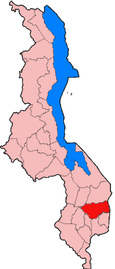
Zomba District
Encyclopedia

Districts of Malawi
||Malawi is divided into 28 districts within three regions. Each District is headed by a District Commissioner:*Central Region**1 Dedza**2 Dowa**3 Kasungu**4 Lilongwe**5 Mchinji**6 Nkhotakota**7 Ntcheu**8 Ntchisi**9 Salima* Northern Region...
in the Southern Region
Southern Region, Malawi
The Southern Region of Malawi, population 5,876,784, covers an area of 31,753 km². Its capital city is Blantyre.Of the 28 districts in Malawi, 12 are located within the Southern Region They are: Balaka, Blantyre, Chikwawa, Chiradzulu, Machinga, Mangochi, Mulanje, Mwanza, Neno, Nsanje,...
of Malawi
Malawi
The Republic of Malawi is a landlocked country in southeast Africa that was formerly known as Nyasaland. It is bordered by Zambia to the northwest, Tanzania to the northeast, and Mozambique on the east, south and west. The country is separated from Tanzania and Mozambique by Lake Malawi. Its size...
, surrounded by the Districts of Chiradzulu, Blantyre, Mulanje, Phalombe, Machinga, Balaka and the Republic of Mozambique to the east. The total land area is 2,580 km², representing three percent of the total land area of Malawi.
Demographics
The District has a total population of 583,167 (2008) resulting in a population density of 230 persons per km², more than half (52.6%) of whom are 18 years or younger. The annual population growth rate over the last decade was two percent. The main ethnic groups are Mang'anjaMang'anja
The Mang'anja are a Bantu people of central and southern Africa, particularly around Chikwawa in the Shire River valley of southern Malawi. They speak a dialect of the Nyanja language, and are a branch of the Amaravi people. As of 1996 their population was estimated at 2,486,070....
/Nyanja, Yao and Lomwe. Chinyanja is the native language spoken by most of the inhabitants, although other languages like Chiyao and Chilomwe are also spoken. The two dominant religions are Christianity (78%) and Islam (20%).
local Government & Administration
There are nine National AssemblyNational Assembly of Malawi
The unicameral National Assembly of Malawi is the country's legislative body. It consists of Members of Parliament from each constituency. They are more commonly addressed as "Members of Parliament" or "MP's"....
constituencies in Zomba: Zomba Central, Zomba Chingale, Zomba Changalume, Zomba Chisi, Zomba Likangala, Zomba Lisanjala, Zomba Msondole, Zomba Ntonya and Zomba Thondwe. Since the 2009 election
Malawian general election, 2009
A general election was held in Malawi on 19 May 2009. President Bingu wa Mutharika ran for re-election; his main opponent was John Tembo, the President of the Malawi Congress Party . Five other candidates also ran. The election was won by Mutharika, who was re-elected to the Presidency with around...
all of these constituencies have been held by members of the Democratic Progressive Party
Democratic Progressive Party (Malawi)
The Democratic Progressive Party is the ruling political party in Malawi. The party was formed in February 2005 by Malawian President Bingu wa Mutharika after a dispute with the United Democratic Front....
.
Economics
The economy of Zomba District is dominated by agriculture, where individual maize production accounts for the main activity, while tobacco is cultivated as the main cash crop. Other crops produced include rice, cassava, sweet potato, groundnuts, beans and pigeon peas. Husbandry is still underdeveloped; nevertheless cattle, poultry, goats, sheep, pigs and rabbits are raised for meat production in Zomba, with poultry being the most common. Zomba on the other hand is one of the few Districts with well-spread pond-fishing. There are around 2,600 farmers engaged in aquaculture, operating more than 5,000 ponds and producing as much as 757 tonnes of fish annually. In addition, Lake Chilwa continues to be the main source of fish in the District, with an annual catchment of more than 5,000 tonnes.Small and medium-scale businesses dominate the District’s non agro-based economy, with general retail accounting for the gross of sales. Employment has increased to almost 97% of the total adult (15+) population, resulting in historically low unemployment. Services, general labour, and professional and technical groups are the dominant occupation groups.

